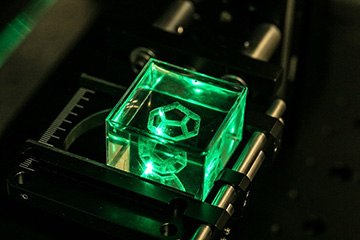
Researchers have developed a new laser-based process for 3D printing intricate parts made of glass. It uses multiphoton polymerization to create an object directly in a 3D volume. [Image: Laurent Gallais, The Fresnel Institute and École Centrale Marseille]
Additive manufacturing, commonly known as 3D printing, plays an important role in areas such as medicine, design, architecture and construction. Although several different processes exist, they traditionally involve the accumulation of two-dimensional slices on top of one another to form a 3D object. This layer-by-layer approach is time-consuming and requires building supports for complex parts.
A team of researchers from France has developed a new laser-based process that can directly create 3D glass objects without the need to build up 2D layers (Opt. Lett., doi: 10.1364/OL.414848). The proof-of-concept study demonstrates the technique’s potential applications for photonics and other fields that require the fast prototyping of glass parts.
Problems with printing glass
The 3D printing of glass has proven challenging because of the material’s fickle nature. Printing glass requires high temperatures, which adds technical complexity, and current methods tend to result in overly fragile or opaque objects. In addition, glass-based filaments are vulnerable to thermal stresses and can fail to merge together in the final print, forming a coarse rather than smooth surface.
To avoid these pitfalls, Laurent Gallais and his colleagues—including Jean-Claude André, a member of the first team of inventors to file a patent on 3D printing—aimed to come up with a 3D printing process for glass that did not involve the layer-by-layer approach.
“The common approach to build arbitrarily shaped parts with current 3D printing technologies is to create multiple 2D slices and then stack these slices to form the 3D object,” said Gallais, study author and professor at the Institut Fresnel and Aix-Marseille Université, France. “The interest of the laser process we present is that one can avoid going through the layer stage and achieve true 3D printing.”
A unique mixture
Their approach applies an existing 3D-printing process called two-photon polymerization (TPP), which uses an ultrashort pulse laser to sketch out solid 3D objects inside a volume of liquid. The simultaneous absorption of two photons within a spatially localized focal point induces a chemical reaction that leads to polymerization. The fabricated 3D structure can then be easily removed from the unpolymerized liquid.
For TPP to create glass components, Gallais and his colleagues needed to prepare a special mixture of a colorless, viscous monomer and a solvent loaded with silica nanoparticles. The mixture required high viscosity to stabilize the 3D object as it is being built, as well as transparency at the laser operating wavelength. Lastly, a photo-initiator was added to kick-start the polymerization process.
The researchers poured the mixture into a transparent tank on a computer-controlled stage, whose movement was synchronized with the irradiation from a femtosecond laser. They were able to produce miniature glass models of a bicycle and the Eiffel Tower without pores or cracks, having voxels as small as tens of microns in length.
Applications abound
The final products still have some flaws, such as a degree of roughness that prevents total transparency. The process also requires thermal post-treatments, which involve the removal of additives and sintering in a high-temperature furnace, and is relatively costly. But such a method, when further optimized, could greatly benefit industries that require glass components with complex structures and tailored properties.
“One of the potential applications we are working on is the production of free-form optics for laser applications. However, other potential applications could be found, since potentially any 3D glass shape could be produced,” said Gallais. “At this point, we would like to explore new combinations of laser sources and mixtures preparations to make the process cheaper.”
